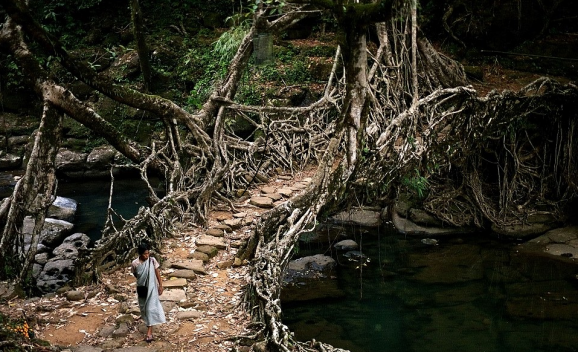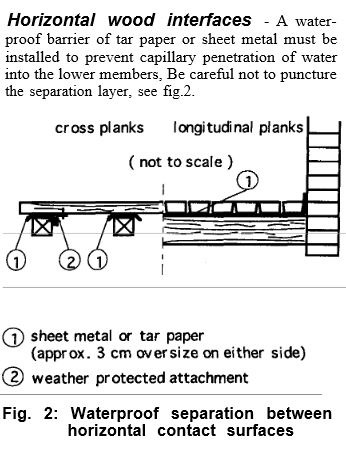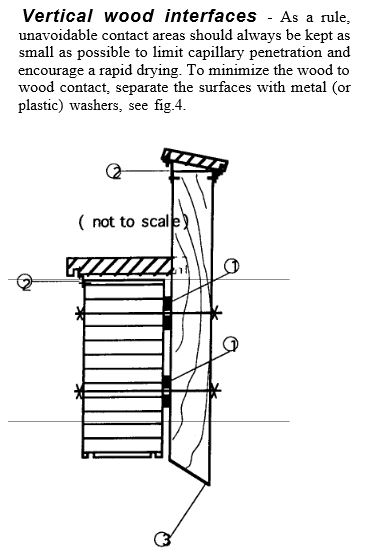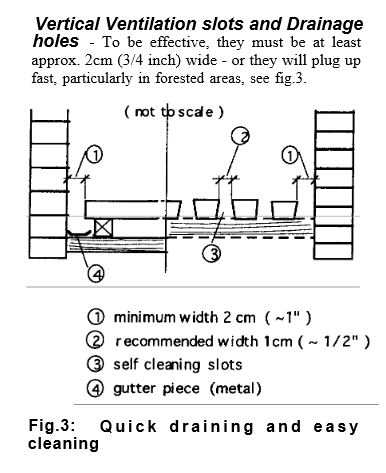Resources:
- The Trail Bridge Catalog Web site is intended to help land managers and engineers select trail bridge types, decks, rail systems, abutment systems, and materials.
- Wetland trail design and construction: PDF version | Web version
- Trail Bridge Rail Systems: fs.fed.us/t-d/pubs/pdfpubs/pdf07232329/pdf07232329dpi300.pdf
- ^Note that I disagree with the use or need for “curbs” or bull rails on decking for bridges less than 4 feet high for which there is no railing, at least when bikes are involved. The edge might be easier to see, but a bike that is not deflected may catch the edge and eject the rider onto their side, back, or head. Granted, riding straight off can cause a rider to land on their head as well. Lastly, 4 feet seems a little high for my taste. Besides the fact that OSHA requires rails if over 4 feet high, have you ever fallen or jumped from 4 feet high? 3 feet?
- ^^In addition, a 4 feet minimum clear width (between curbs) for bikes seems a bit wide unless the bridge is over 3 feet high or over 30 feet long. Of course differentiating between a bridge for all and the purpose of utility versus a “skinny” for thrill and skill is not a black and white issue.
- OSHA for bridges: PDF

Prefabricated Bridges
- arete structures
- rolling barge
- bedford reinforced
- orenco composites
- creative composites
- acrow
- pioneer bridges
- conteches
Culverts
- Culvert Sizing procedures for the 100-Year Peak Flow
- How to calculate diameter
- North Carolina Forest Service: Culverts; Talbot’s Formula Excel Spreadsheet
- USFW: Culvert Design Guidelines for Ecological Function
- CULVERT CRITERIA FOR FISH PASSAGE
Engineering
Ultimately most bridge plans need an engineer’s stamp of approval or language stating “no exceptions taken.” Unless of course you do something like the work of art above…which may not fly in most municipalities. What follows below is not advice, but some background on how to determine load capacities and factors of safety for smaller projects should you be so inclined to cross that bridge.
Using Auto Desk Force Effect for Distributed loads
Sadly Force Effect has stopped support, downloads and their apps.
DIY Needs:
The stress applied to stringers, not to mention the deck planks, needs to be determined. The applied stress should be less than the Modulus of Rupture for the stringers. Also, the Factor of Safety (FoS) should be determined, which is: Failure Load / Applied Load. FoS for steel bridges is usually 5 to 7. At this time I don’t know the recommendation for wood, but imagine it is at least 3, but 5-7 would be safer. The FoS may vary from state to state. The deflection limit for steel is often L/500, for wood L/360, but I don’t know that these notations are used anymore. L/360 means the maximum deflection should be less than the span (inches) divided by 360 (max D= L/360).
- 1. Start here: Basic Timber Design Concepts for Bridges
- 2. Modulus of Elasticity and Rupture for the wood to be used:
- Those numbers can be found here: Woods Data Base: examples: White Oak | Black Locust | Red Cedar
- National Design Specs for Wood
- Mechanical Properties of Wood
- There are some stringer loads in tables on these drawings: logs |sawn
- 3. The loads need to be estimated for those equations:
- Live Loads: “For bridges designed for only pedestrian and/or bicycle traffic, use a
live load of 85 psf.” AASHTO, but now 90? - Load Combination = [(D + W + L + S)*0.75] ASCE 7
- Live Loads: “For bridges designed for only pedestrian and/or bicycle traffic, use a
- 4. The numbers above are needed for these equations:
- More:
Green Lumber vs Dry/Seasoned Lumber
- Green lumber
- softer than seasoned wood
- cut more easily
- not as likely to split
- nails more easily
- dry and shrink, leaving nails elevated
- it can warp and check/crack as it dries
- mold can start to decay the wood, before it is even used
- will rot faster than dry wood
- the moisture content is preferred by wood boring insects
- Dry/seasoned lumber (Kiln Dried (KD), Heat Treated (HT), Air Dry)
- less susceptible to shrinking and expanding
- air dried is less brittle than KD
- KD and HT can kill internal insects in the wood at harvest
Drying Green Lumber (“a year per inch thick”)



Pingback: Stairs and Bridges, the Sane and Insane – Trailism